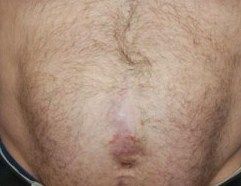What is Definition of Ventral Hernia
When a ventral hernia occurs in any patient, it usually occurs in the anterior abdominal wall where a either a previous surgical incision was made or there is any trauma. In ventral hernia the abdominal muscles become weak and this results in a bulge or a tear called as hernia. This weakness of abdominal can allow a loop of intestines or other abdominal visceral content or momentum to push into the sac of hernia. If the abdominal contents unfortunately get stuck within the hernia sac, they can become incarcerated. This complication of incarceration of bowel could lead to potentially serious problems that might require emergency surgery otherwise infarction of bowel can result.

What causes the Ventral Hernia?
Actually anyone can get a ventral hernia at any age in his life. They are more common as one get older and abdominal wall get thinner. In some patient few unusual activities increase the chances of a ventral hernia including long standing job, frequent heavy weight lifting, persistent coughing, difficulty with bowel movements or urination, or frequent need for straining.
What are the advantage of Laparoscopic repair of Ventral Hernia?
Most common advantages of laparoscopic repair of ventral hernia may include:
- Less post-operative pain
- Shortened hospital stay and early discharge
- Faster return to regular diet and
- Quicker return to normal activity and work
How the laparoscopic repair of ventral hernia done?
The laparoscopic surgeon during laparoscopic repair of ventral hernia done may choose to sew patients natural tissue back together, but frequently, it requires the placement of mesh in or on the abdominal wall for a repair. This technique of laparoscopic repair of ventral hernia done is most often performed under a general anesthesia. In laparoscopic ventral hernia repair a laparoscope is inserted through a cannula. The laparoscope and monitor allow the surgeon to view the ventral hernia from the inside.
During laparoscopic repair of ventral hernia done few more small incisions will be required for other thin laparoscopic instruments to remove any scar tissue and to insert a ultra fine surgical mesh into the abdomen. This mesh is selected by the surgeon carefully and there are many options are available. The mesh is fixed under the ventral hernia defect to the strong tissues of the abdominal wall. It is held in place with special laparoscopic surgical tacks and in many instances, sutures. Usually, three five and ten mm incisions are necessary to perform laparoscopic ventral hernia. The sutures or tackers, which go through the entire thickness of the abdominal wall, are placed through smaller incisions around the circumference of the mesh in double crowning pattern. This laparoscopic operation is usually performed under general anesthesia.
What complication can happen after laparoscopic repair of ventral hernia?
Laparoscopic repair of ventral hernia operation is considered safe and effective, However, complications may occur as they might occur with any other operation, and you should consult your laparoscopic surgeon about your specific case. Complications of laparoscopic repair during the operation may include adverse reactions to general anesthesia, bleeding, or injury to the small intestines or other abdominal organs. Sometime infection occurs in the mesh introduced during laparoscopic surgery, it may need to be removed or replaced. Some other possible complication of this surgery include pneumonia, blood clots or heart problems if patient has any pre-existing cardiac disease and is prone to them. Also, any time a hernia is repaired it can re occur.
After Laparoscopic repair of ventral hernia the long-term recurrence rate is not yet known. The early results of statically indicate that it is as good as the standard or traditional open surgical approach. Laparoscopic surgeon will help the patient decide if the risks of laparoscopic ventral hernia repair are less than the risks of leaving the condition untreated. It is important to keep in mind that before undergoing any type of surgery, whether laparoscopic or traditional, patient should discuss with the surgeon about his her training and experience in ventral hernia surgery.





